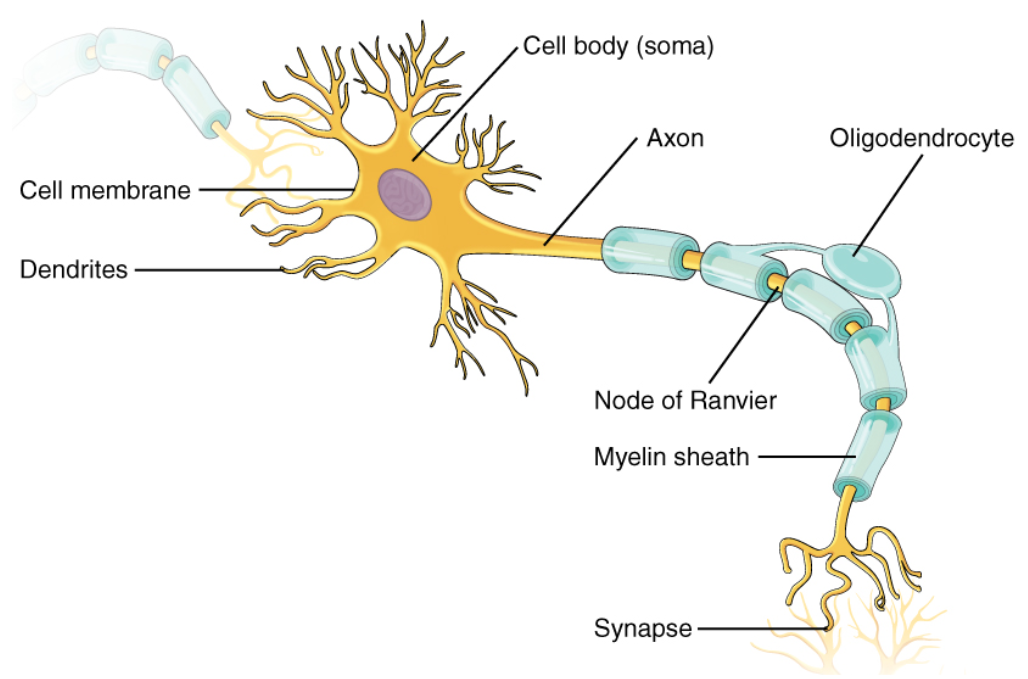
Which of the following statements about the transmission of the nerve impulse is correct?
a. A nerve impulse travels from the dendritic end towards the axonal end.
b. At the dendritic end, electrical impulses bring about the release of some chemical which generates an electrical impulse at the axonal end of another neuron.
c. The chemical released from the axonal end of one neuron crosses the synapse and generates a similar electric impulse in a dendrite of another neuron.
d. A neuron transmits nerve impulses not only to other neurons but also to muscles and gland cells.
A. a and c
B. b and d
C. a, c and d
D. b, c, and d
Answer
570.9k+ views
Hint: The transmission of nerve impulses from one end to another is due to the electrical changes across the membrane of neurons. The charge difference is due to the concentration of sodium and potassium inside and outside the membrane.
Complete Answer:
Neurons are present in the brain and spinal cord. They have specialised cells which transmit nerve impulses to another neuron as well as muscle or gland cells. The neurons have dendrites which extend from the cell body. They are specialised to receive chemical signals. Axons are the other terminal of neurons. The junction at which the dendrites of one neuron meet the axon of another is known as synapse (as shown in the diagram below)

The nerve impulses are generated at the sensory receptors and are being brought to CNS by the sensory neurons. The nerve impulse is transmitted by the axon of one neuron to the dendrite of another and through dendrite to axon of another neuron through synapse.(Statement A is correct)
These synapses have telodendrites (by the axons) which secrete neurotransmitters which aid in transmitting the impulses to the dendrons. (Statement c and d are correct)
The correct answer is (C).
Note: The neurons are of two types the sensory neurons which are involved in taste, smell, hear, see, feel and the motor neurons which play important role in movement both voluntary and involuntary.
Complete Answer:
Neurons are present in the brain and spinal cord. They have specialised cells which transmit nerve impulses to another neuron as well as muscle or gland cells. The neurons have dendrites which extend from the cell body. They are specialised to receive chemical signals. Axons are the other terminal of neurons. The junction at which the dendrites of one neuron meet the axon of another is known as synapse (as shown in the diagram below)

The nerve impulses are generated at the sensory receptors and are being brought to CNS by the sensory neurons. The nerve impulse is transmitted by the axon of one neuron to the dendrite of another and through dendrite to axon of another neuron through synapse.(Statement A is correct)
These synapses have telodendrites (by the axons) which secrete neurotransmitters which aid in transmitting the impulses to the dendrons. (Statement c and d are correct)
The correct answer is (C).
Note: The neurons are of two types the sensory neurons which are involved in taste, smell, hear, see, feel and the motor neurons which play important role in movement both voluntary and involuntary.
Recently Updated Pages
Master Class 11 Economics: Engaging Questions & Answers for Success

Master Class 11 English: Engaging Questions & Answers for Success

Master Class 11 Social Science: Engaging Questions & Answers for Success

Master Class 11 Biology: Engaging Questions & Answers for Success

Class 11 Question and Answer - Your Ultimate Solutions Guide

Master Class 11 Business Studies: Engaging Questions & Answers for Success

Trending doubts
10 examples of friction in our daily life

One Metric ton is equal to kg A 10000 B 1000 C 100 class 11 physics CBSE

Difference Between Prokaryotic Cells and Eukaryotic Cells

1 Quintal is equal to a 110 kg b 10 kg c 100kg d 1000 class 11 physics CBSE

State the laws of reflection of light

Explain zero factorial class 11 maths CBSE




